The Epic Global Battle Over Crude Oil and the US Dollar
Commodities / Crude Oil Nov 30, 2007 - 06:07 AM GMTBy: Gary_Dorsch

 “Here are two brother countries, united like a single fist,” declared Venezuelan kingpin Hugo Chavez after meeting Iran Mahmoud Ahmadinejad in Tehran on Nov 19th. “We have common viewpoints and we will stand by each other until we capture the high peaks. God is with us and victory is awaiting us,” added Iran's Ahmadinejad, vowing to defeat US imperialism together, and pointing to the fall of the US dollar as the prelude to the end of America's global dominance.
“Here are two brother countries, united like a single fist,” declared Venezuelan kingpin Hugo Chavez after meeting Iran Mahmoud Ahmadinejad in Tehran on Nov 19th. “We have common viewpoints and we will stand by each other until we capture the high peaks. God is with us and victory is awaiting us,” added Iran's Ahmadinejad, vowing to defeat US imperialism together, and pointing to the fall of the US dollar as the prelude to the end of America's global dominance.
“Don't you see how the dollar has been in free-fall without a parachute? The US prints dollar bills with no real economic foundation. Soon we will not talk about dollars, because the empire of the dollar is crashing. The day will arrive not only in OPEC, but also in Latin America, when we will be liberated from the dollar. With the fall of the US dollar, US imperialism will fall as soon as possible,” Chavez declared.
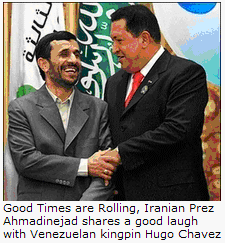 Why are Ahmadinejad and Chavez laughing? Oil prices are up 56% this year, after nearly reaching $100 per barrel. At the same time, the US Dollar is mired at a 20-year low, with the US economy teetering on the verge of a recession. The US dollar has fallen over 50% versus the Euro since 2002, and oil prices are nearly five times higher over the same time period. Increasingly, the US dollar's reserve currency status is looking very fragile. Perhaps, all that's left supporting the greenback is America's military might. “They get our oil and give us a worthless piece of paper,” Ahmadinejad told OPEC ministers in the Saudi capital of Riyadh, insulting the US dollar.
Why are Ahmadinejad and Chavez laughing? Oil prices are up 56% this year, after nearly reaching $100 per barrel. At the same time, the US Dollar is mired at a 20-year low, with the US economy teetering on the verge of a recession. The US dollar has fallen over 50% versus the Euro since 2002, and oil prices are nearly five times higher over the same time period. Increasingly, the US dollar's reserve currency status is looking very fragile. Perhaps, all that's left supporting the greenback is America's military might. “They get our oil and give us a worthless piece of paper,” Ahmadinejad told OPEC ministers in the Saudi capital of Riyadh, insulting the US dollar.
The more the US dollar slides, the less foreign investments in the US capital markets are worth, and the more likely that foreigners could withdraw en masse. If that were to happen, the greenback would collapse. “The dollar is losing its status as the world currency,” warned Chinese central bank director Xu Jian on Nov 7th. “We will favor stronger currencies over weaker ones, and will readjust accordingly,” added Cheng Siwei, vice chairman of China's National People's Congress, signaling plans to diversify Beijing's $1.43 trillion of foreign exchange reserves.
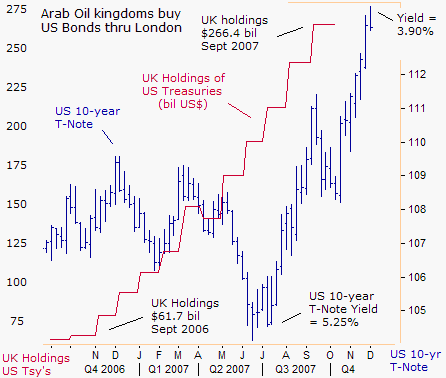
Over the past six months, China, Japan, South Korea, and Taiwan have been net sellers of $65 billion of US Treasuries. However, the Arab Oil kingdoms have picked up the slack, boosting their holdings of US Treasuries, thru their agents in London, and providing the dollar with vital life support. Holdings of US Treasuries from the United Kingdom have soared by $205 billion from a year ago, allowing Asian central banks to scale down their exposure to US bonds in an orderly fashion.
The Arab Oil kingdoms are plowing petro-dollars into US Treasuries, but are also facing the same quagmire that's entrapping China, - an inevitable devaluation of their pegged currencies versus the US dollar. Earlier today, the Dubai-based Arabian Business magazine fed speculation of a UAE dirham revaluation of 3-5% as early as this weekend, pushing the Saudi riyal to a 21-year high and the Qatar riyal to a five-year high against the dollar, on ideas of a coordinated currency shift.
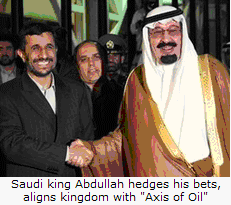 Now, Washington is asking the Saudi king for more big favors, - maintain the Saudi riyal peg to the dollar at all costs, and start pumping more oil this winter, to keep prices from climbing above $100 /barrel. But keeping the dollar peg intact threatens the Saudi kingdom will hyper inflation and social unrest. Pumping more oil endangers budding relations with Iran, and could trigger a sharp downturn in the Saudi stock market, which is just starting to recover from a brutal 60% correction.
Now, Washington is asking the Saudi king for more big favors, - maintain the Saudi riyal peg to the dollar at all costs, and start pumping more oil this winter, to keep prices from climbing above $100 /barrel. But keeping the dollar peg intact threatens the Saudi kingdom will hyper inflation and social unrest. Pumping more oil endangers budding relations with Iran, and could trigger a sharp downturn in the Saudi stock market, which is just starting to recover from a brutal 60% correction.
Iranian president Ahmadinejad would love to see Saudi king Saudi King Abdullah bin Abdulaziz Al Saud pull the plug on the 21-year old, US-dollar peg to the Saudi riyal. Tehran has cut all ties with the dollar when it comes to oil transactions. “This is an economic decision and we've been proven right. Over time the dollar has got weaker and weaker,” explained Hojjatollah Ghanimifard, director of the National Iranian Oil Company. “Less than 20% of Iran's oil export earnings are in yen and the rest in euros,” he said. Tehran is fetching $90 a barrel on oil sales of 2.4 million bpd.
Such a stunning move by King Abdullah to price Saudi oil in Euros or a basket of foreign currencies would knock the US dollar into a tailspin. “There will be journalists who will seize on this point and we don't want the dollar to collapse instead of doing something good for OPEC,” whispered Saudi Prince Faisal al-Saud, during a key closed meeting, when microphones were not cut off.
The Fed Monetizes Record high Food and Oil Prices
Ahamdinejad's assertion that foreign central banks are printing worthless paper currency in exchange for OPEC's oil is right on target, and fully understood by the political leaders, who control 75% of the world's proven oil reserves. The Federal Reserve has allowed the MZM money supply to expand by $850 billion this year, up 13% from a year ago. The broader US M3 money supply is 15.8% higher, it's fastest in history, monetizing the prices of crude oil and gold, key hedges against inflation, to all-time highs.
Explaining the Fed's reason for ignoring sharply higher food and energy prices, on October 20th, Federal Reserve governor Frederic Mishkin said, “Changes in price indexes without food and energy provide a clearer picture of underlying inflation pressures. If the monetary authorities react to headline inflation numbers, they run the risk of responding to merely temporary fluctuations,” he said. At the same time, Mishkin said it was the Fed's job to “counteract negative shocks to the economy,” from high oil prices, suggesting a further expansion of the money supply.
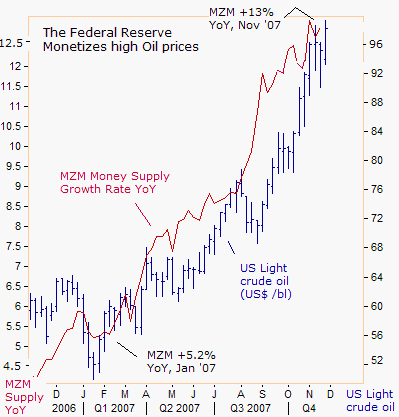
“Our emphasis over the years has been more on core inflation, which strips out food and energy, because we think that's a better predictor of future total inflation than today's total inflation has been,” said Fed governor Donald Kohn on Nov 28th. Instead, “Uncertainties about the economic outlook are unusually high right now, and require flexible and pragmatic policy-making,” Kohn said, widely interpreted by traders as a signal the Fed would continue to inflate the money supply to pump up the stock market in the months ahead.
The price of crude oil has finally caught up with rate of inflation. Depending on how the adjustment is calculated, crude oil's price spike to as high as $38 a barrel in the 1970's, would be the equivalent to $96 to $103 /barrel today. But it's not just the US central bank that is clandestinely monetizing the high cost of oil these days. China's M2 money supply is 18.5% higher, and India's M3 is up 21% this year. If the Chinese and Indians consumed as much oil per capita as Americans do, the world's oil demand would be closer to 200 million bpd, instead of 86 million barrels today. That day is expected to arrive around 2030.
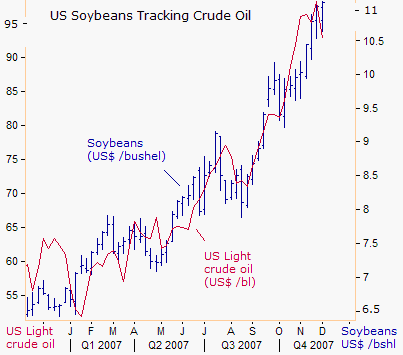
With oil prices approaching $100 this month, the United Nations Food and Agricultural Organization (FAO) reported that at $100 a barrel, the price of oil has sent the cost of food imports skyrocketing this year. What's more, worldwide food reserves are at their lowest in 35-years, so prices are likely to stay high for the foreseeable future. The Baltic Dry Index, which measures the cost of shipping agriculture and minerals, is up 150% from a year ago, to all time highs.
“Past shocks have quickly dissipated, but that's not likely to be the case this time. Supply and demand have become unbalanced, and can't be fixed quickly,” the FAO warned on Nov 16th. The world's food import bill is on course to rise 21% to $745 billion in 2007. In developing countries, imported food costs will go up by 25% to nearly $233 billion, due to strong global demand for bio-fuel crops, extreme weather and growing demand from countries like India and China.
Yet the Fed still clings to the “core rate” of inflation, which strips out the essential costs of life, when setting monetary policy. As the famous economist John Maynard Keynes, used to say, “By a continuing process of inflation, governments can confiscate, secretly and unobserved, an important part of the wealth of their citizens. There is no subtler, no surer means of overturning the existing basis of society than to debase the currency. The process engages all the hidden forces of economic law on the side of destruction, and does it in a manner which not one man in a million is able to diagnose.”
European Central Bank fuels high Oil Prices
The European Central Bank has also been a big contributor to the global inflation problem, by clandestinely monetizing the price of crude oil to record highs. Under Jean “Tricky” Trichet, the ECB has expanded the Euro M3 money supply at a 12.3% annualized rate, far above the central bank's original target of 4.5% growth, while giving empty lip service to “vigilance” against inflation.
But now the ECB's strategy is backfiring. Food-price inflation in the 13-nation Euro region accelerated to +3.8% in October, the highest rate since March 2002. Fuel was +9% higher in the past year. It's easy to see how much EuroStat doctors up the Euro zone's inflation rate. Crude oil has risen 60% in the last 12-months and the price of wheat has increased 43% this year. The cost of shipping dry goods across the sea, as measured by the Baltic Dry Index is up 150% from a year ago.
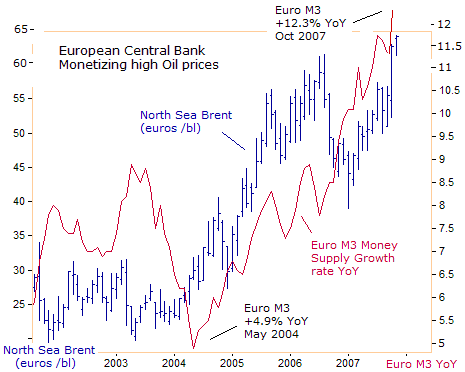
But on Nov 15th, with crude oil bumping up against $100 /barrel, Bank of Spain chief Miguel Angel Fernandez Ordonez broke ranks with Trichet and his fiery band of inflationists. “The persistence of energy and food price increases entails the serious risk that inflation expectations could become unhinged. As a result, our credibility as central bankers could be significantly damaged,” he warned.
But Trichet continued to defend his monetization of the crude oil market on Nov 29th. "It's clear that the price of oil is something on which we have no influence immediately. But we do have a decisive influence on this increase in the price of oil by not injecting its influence into second round effects. That is where we have our own duty." In other words, the ECB won't lift its interest rates to combat higher food and energy prices, but would react with a tighter money policy, if European workers demand higher wages, to pay for the higher costs of existing.
Fed Rate cuts wreak havoc on Saudi Riyal
The Fed's daily money injections and expectations of more rate cuts, are threatening to transmit hyper-inflation to the Persian Gulf kingdoms. The Bernanke Fed is pursuing a radical monetary policy, expanding the US M3 money supply at a 15.8% annual rate, its fastest in history, and inviting speculators to sell the dollar in exchange for Saudi riyals. To counter the dollar's weakness, the Saudi Arabian Monetary Authority (SAMA) is expanding the Saudi M3 money supply at a 19.5% annual growth rate, engaging in a round of competitive currency devaluations with the Fed, to keep the 21-year old dollar – riyal peg intact.
Last week, the Saudi Arabian Monetary Agency (SAMA), reduced its reverse repo rate by 50 basis points to 4.25%, and the UAE's central bank cut rates by as much as 20 basis points, despite inflation raging a decade highs, to relieve pressure on the weak dollar. But the dollar remains pinned at a 17-year low against the UAE dirham surged and a 21-year low against the Saudi Arabian riyal, as traders bet the Persian Gulf kingdoms would be unable to maintain their pegs to the dollar and fight inflation at the same time.
And because the Saudi riyal is pegged to the US dollar, the Euro is 50% higher from five years ago to a record 5.5 Saudi riyals, increasing the costs of import prices from Europe. Inflation in Gulf countries is leading to calls for a wage hike in Saudi Arabia, rent caps in other states, widespread complaints from business leaders, and riots by migrant workers in the UAE demanding better pay. Further Federal Reserve rate cuts designed to bail out Wall Street from the sub-prime debt crisis, could put unbearable pressure on Saudi Arabia and other Gulf oil producers to drop their currency pegs to the tumbling dollar.
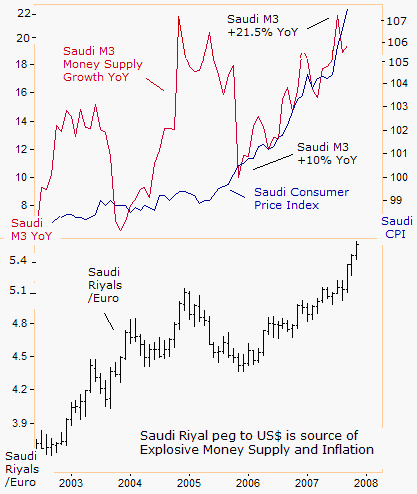
So far, despite the enormous pressure to revalue the dollar peg, King Abdullah has been holding the line with the greenback. The Saudi royal family has a secret agreement with Washington, dating back to the early days of Saudi oil, which barters US military protection for the desert kingdom, in exchange for the Saudis making sure that crude oil stays priced in US dollars. The US military umbrella also extends to the tiny Persian Gulf satellites. That forces oil importers to buy roughly $1.5 billion per day of US dollars, in exchange for the oil that OPEC sells on world markets.
Behind the smiles and handshakes in Riyadh last week, Saudi king Abdullah is very worried about Iran's growing military might, and fears Tehran could stir up the kingdom's own Shiite minority, suspected as a fifth column by Saudi leaders. Saudi Shiites represent 15% of the population and live in the oil-rich Eastern Province, adjacent to Kuwait and Bahrain, which both have sizable Shiite populations.
The Saudi royal family is also worried about Iran's drive for nuclear invincibility. On Nov 15, the UN's nuclear watchdog confirmed that Iran has 3,000 working centrifuges in its nuclear facilities, a ten-fold increase from just a year ago. If those 3,000 centrifuges can be made to work efficiently, Iran could manufacture a nuclear bomb in 12-18 months. Iran said on Nov 27th, it has a new missile named Ashoura, with a range of 1,250 miles that will enable Iran to aim at targets in Europe.
Will Venezuela's Chavez dump the US Dollar?
On Nov 27th, Venezuela Energy Minister Rafael Ramirez stepped up his call for OPEC member states to bill their oil sales in currencies other than the weak US dollar. “The oil price is at $100 a barrel, but what dollar are we talking about? It's a dollar that makes you laugh. The dollar has devalued and it is distorting the oil market because there is a financial crisis knocking on the US door,” Ramirez said. He also pointed to US economic sanctions on Iran that helped push crude toward $100 a barrel.
Until now, Chavez's outlandish comments have been brushed off as the ranting of a raving madman, or a tin-horn crack-pot. But Chavez is one of the most powerful political figures in the world today. He controls the Orinoco oil fields, recognized as the world's single largest known oil deposits, and with the proper development could help Venezuela surpass Saudi Arabia with the most oil reserves. Last June, Chavez ousted US oil giants Exxon Mobil and Conoco Phillips from the Orinoco Belt to consolidate his control.
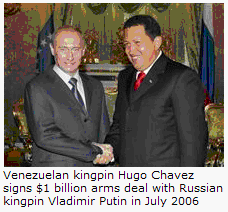 If Chavez gathers the courage to demand non-dollar payments for Venezuelan oil, he could knock the dollar sharply lower, overriding Riyadh's artificial support. Venezuela exports 1.5 mil barrels per day (bpd) to the US, out of a total of 2.6 million bpd, fetching close to $7 billion per month. “We better understand the vulnerabilities to our economy and our lives, when we're dependent on Iranian mullahs, and whackos in Venezuela,'” warned Arizona Senator John McCain on January 22, 2007.
If Chavez gathers the courage to demand non-dollar payments for Venezuelan oil, he could knock the dollar sharply lower, overriding Riyadh's artificial support. Venezuela exports 1.5 mil barrels per day (bpd) to the US, out of a total of 2.6 million bpd, fetching close to $7 billion per month. “We better understand the vulnerabilities to our economy and our lives, when we're dependent on Iranian mullahs, and whackos in Venezuela,'” warned Arizona Senator John McCain on January 22, 2007.
State-run Petroleos de Venezuela is sending more tankers of oil and fuel to India and China this year, markets that are up to seven times more distant than the US, to reduce Chavez's dependence on the US. “The US depends on us, not we on them,'” Chavez said on May 16, when he predicted oil prices would soar to $100 a barrel, if he chose to send its oil to China, Europe and other countries instead of the US.
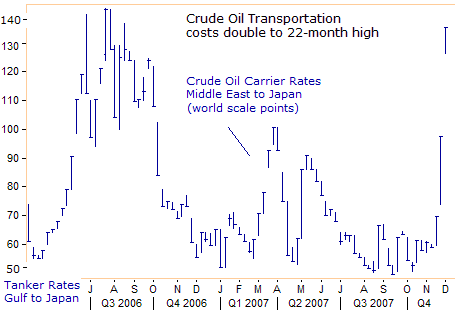
Chavez has boosted oil sales to China and India to 360,000 bpd this year, and is shouldering the higher tanker carrier rates. Soaring global oil prices have made up for lost revenue. Global tanker rates to transport crude oil were stuck at four-year lows this past summer, but have doubled in the past two weeks. That could cost Chavez an extra $6 /barrel to ship his oil to the Far East.
So what's preventing Chavez from switching to non-dollar currencies for Venezuelan oil right now? The maverick Venezuelan leader has often accused President Bush of plotting to invade his oil-rich country, to bring down his regime. Switching oil sales away from the dollar could mean Chavez would suffer the same fate as the late Saddam Hussein. Last year, Chavez signed a $1 billion arms deal with Russian kingpin Vladimir Putin, but 30 Russian fighter jets and a few hundred thousand rifles are not enough to wage a war against a leading military power.
Focus Turns to OPEC meeting in Abu Dhabi on Dec 5th,
Already, the Western media is fanning speculation of a boost in Saudi oil output at the upcoming OPEC meeting in Abu Dhabi, to placate its military patron in Washington and cool oil prices. Within OPEC, Saudi Arabia is the only producer with any capacity to pump more oil. Saudi oil chief, Ali al-Naimi indicated the kingdom had spare oil capacity of 2.3 million bpd. Total OPEC spare capacity is 3 million bpd.
On Nov 21st, former Saudi oil minister Ahmed Zaki Yamani was engaging in psychological warfare with crude oil traders, attempting to “jawbone” oil prices lower. “If there are no disasters, then oil prices could fall to $75 per barrel after the winter,” he said. Already, crude oil has tumbled to $91.50 /bl on expectations that Riyadh will boost its oil output by 500,000 bpd. How myopic have equity traders become, now that $91 for oil is considered cheap, after seeing $99 last week?
“We observe with great concern the recent escalation of oil prices. But we believe that the world market is well supplied and petroleum inventories are comfortable,” said Saudi Oil Minister Ali al-Naimi, on Nov 28th. Asked if OPEC would agree to a second output increase on Dec 5, Naimi was non-committal, “We need to look at the data, at the information, and then we will decide.”
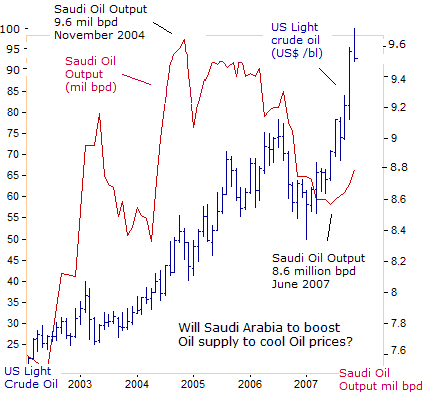
But on Nov 27th, Qatar's Oil Minister Abdullah al-Attiyah downplayed speculation of a boost in OPEC oil output next month. “My personal belief is that for the moment there is no need to increase production. The market is saturated,” he said. Qatar is one of OPEC's smallest producers with oil output of around 830,000 bpd, but its final decisions are usually closely aligned with Saudi Arabia.
OPEC blames foreign central banks for printing too much money, which in turn, encourages speculation in the oil market. “Please don't blame us for $93 oil,” said Qatari Oil Minister Abdullah al-Attiyah on Oct 30th. “The market is increasingly driven by forces beyond OPEC's control, by geopolitical events and the growing influence of financial investors,” said UAE oil chief Mohammed bin Dhaen al-Hamli.
Riyadh's ability to keep the crude oil market under wraps, by pumping more oil might draw to an end by late 2008. The International Energy Agency is forecasting that global demand will climb by 2.1 million bpd to 88 million bpd next year. Global supply however, is forecast to rise a scant 200,000 bpd to 85.6 million bpd, leaving a growing shortfall that would exhaust all of Saudi's spare capacity.
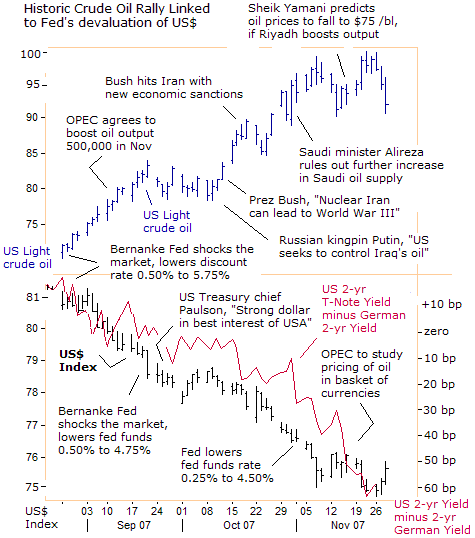
In the short term, the direction of oil prices might depend upon the Federal Reserve. “Nobody should ask OPEC to do something to lower oil prices, because even if OPEC introduces another 500,000 barrels of oil next month, the price is not going to change unless the dollar corrects itself,” said Iranian Oil Company chief Hojatollah Ghanimifard. “The US Treasury should take measures to strengthen its currency if it doesn't want oil prices to continue rising,” he said.
No matter how high commodities zoom upward, the ECB is expected to continue its super-easy money policy. To brainwash the public, the ECB's Vitor Constancio described the historic rise in food and energy prices as, “A temporary phenomena that will dissipate in March next year. We cannot interpret this inflation rise as something permanent. We are not faced with a situation where the process of inflation is out of control in Europe,” he said.
But there are some voices of sanity in the Federal Reserve network, calling for the US Treasury to halt the reckless debasement of the US dollar. On Nov 27th, Philly Fed chief Charles Plosser said, “In the current environment, providing insurance through a reduction in the fed funds rate creates its own set of additional risks. A lower funds rate creates a risk that inflation may be exacerbated and inflationary expectations may begin to rise. In some circumstances, lowering interest rates may prolong the painful process of price discovery,” he said.
“In my view, if the FOMC members already expected some bad economic numbers and had already taken those into account in their outlooks when they set the fed funds rate target, then you should only see policy-makers take action when the outlook changes significantly, not on a few bits and pieces of news,” Plosser added. However, the Philly Fed chief will not have a vote at the Fed's next meeting on Dec 11th. His job is to sound hawkish, and create doubts and confusion in the minds of dollar bears and gold bugs.
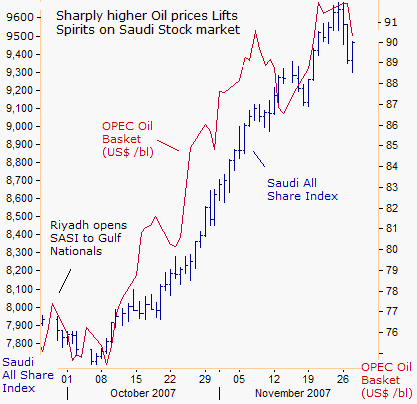
Clearly, the US Treasury expects a quick fix to the Global “Oil Shock” from King Abdullah to cap global oil prices, by boosting Saudi oil output next month. That would permit the Fed to lowers its lending rates and inject more dollars into the hands of Wall Street dealers, while keeping the “crude oil vigilantes” at bay. But a move by the Saudis to knock oil prices lower could also inflict damage on its own stock market, which is just starting to shake off a nasty two year hangover.
The Saudi All Share Index (SASI) has surged 20% over the past five weeks, kicked off by a rush of Gulf capital into the local markets, and the recent boom in oil prices. Saudi Arabia lifted remaining restrictions on citizens from Kuwait, the United Arab Emirates, Qatar, Oman and Bahrain, for trading in the biggest Arab stock exchange, unleashing SASI from its two year slump. But the rally could fizzle out, if king Abdullah knocks oil prices sharply lower. Since an estimated 7,000 princes in Saudi Arabia own 70% of the stock market, most likely, Abdullah will take the best interests of the royal family into account.
Whether the historic rise in crude oil towards $100 /barrel heralds the arrival of “Peak Oil,” or is just a speculative bubble that will deflate, are just some of the tough questions in today's brave new world of investing.
By Gary Dorsch,
Editor, Global Money Trends newsletter
http://www.sirchartsalot.com
To stay on top of volatile markets, subscribe to the Global Money Trends newsletter today, which includes a special bonus for new subscribers, - “Audio Broadcasts”, posted on Monday and Wednesday evenings, during Asian trading hours, to the Log-In section of our website. This article was just the Tip of the Iceberg , of what's inside the Global Money Trends newsletter, published on Friday afternoon. Here's what you will receive with a subscription,
Insightful analysis and predictions of the (1) top dozen stock markets around the world, Exchange Traded Funds, and US home-builder indexes (2) Commodities such as crude oil, copper, gold, silver, the DJ Commodity Index, and gold mining and oil company indexes (3) Foreign currencies such as, the Australian dollar, British pound, Euro, Japanese yen, and Canadian dollar (4) Libor interest rates, global bond markets and central bank monetary policies, (5) Central banker "Jawboning" and Intervention techniques that move markets.
GMT filters important news and information into (1) bullet-point, easy to understand analysis, (2) featuring "Inter-Market Technical Analysis" that visually displays the dynamic inter-relationships between foreign currencies, commodities, interest rates and the stock markets from a dozen key countries around the world. Also included are (3) charts of key economic statistics of foreign countries that move markets.
To order a subscription to Global Money Trends , click on the hyperlink below,
http://www.sirchartsalot.com/newsletters.php
Mr Dorsch worked on the trading floor of the Chicago Mercantile Exchange for nine years as the chief Financial Futures Analyst for three clearing firms, Oppenheimer Rouse Futures Inc, GH Miller and Company, and a commodity fund at the LNS Financial Group.
As a transactional broker for Charles Schwab's Global Investment Services department, Mr Dorsch handled thousands of customer trades in 45 stock exchanges around the world, including Australia, Canada, Japan, Hong Kong, the Euro zone, London, Toronto, South Africa, Mexico, and New Zealand, and Canadian oil trusts, ADR's and Exchange Traded Funds.
He wrote a weekly newsletter from 2000 thru September 2005 called, "Foreign Currency Trends" for Charles Schwab's Global Investment department, featuring inter-market technical analysis, to understand the dynamic inter-relationships between the foreign exchange, global bond and stock markets, and key industrial commodities.
Copyright © 2005-2007 SirChartsAlot, Inc. All rights reserved.
Disclaimer: SirChartsAlot.com's analysis and insights are based upon data gathered by it from various sources believed to be reliable, complete and accurate. However, no guarantee is made by SirChartsAlot.com as to the reliability, completeness and accuracy of the data so analyzed. SirChartsAlot.com is in the business of gathering information, analyzing it and disseminating the analysis for informational and educational purposes only. SirChartsAlot.com attempts to analyze trends, not make recommendations. All statements and expressions are the opinion of SirChartsAlot.com and are not meant to be investment advice or solicitation or recommendation to establish market positions. Our opinions are subject to change without notice. SirChartsAlot.com strongly advises readers to conduct thorough research relevant to decisions and verify facts from various independent sources.
Gary Dorsch Archive |
© 2005-2022 http://www.MarketOracle.co.uk - The Market Oracle is a FREE Daily Financial Markets Analysis & Forecasting online publication.


